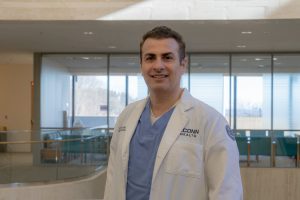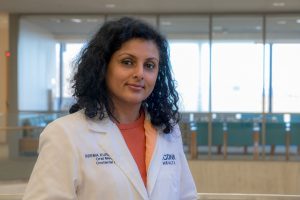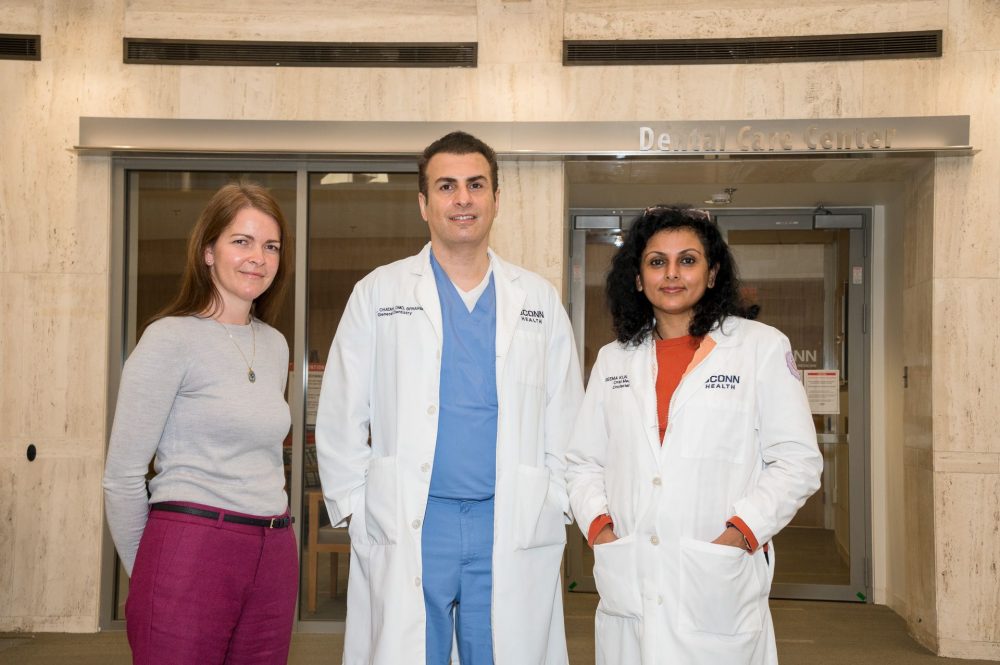With tragic stories of opioid and pain medicine misuse an all-too-common feature of the news, it’s important to focus on the reason these drugs were developed in the first place: to help reduce or control patient suffering from chronic illnesses, surgery, oral and dental procedures, accidents, and a wide range of physical maladies. To ensure proper prescribing regimens for medical and dental conditions, UConn Health has been a proactive leader in pain-management education, leadership and outreach, in the clinic and in the classroom.
Two UConn School of Dental Medicine (SDM) pain-management specialists, Drs. Elias Chatah and Seema Kurup, and Helena Hilario, quality improvement advisor, have been focusing on a multi-disciplinary and multi-faceted approach to pain management and substance misuse prevention that includes new curricula for dental students and residents, as well as provider education, collaboration with state and federal agencies and the creation of related tools for providers and students.
The challenge, say Chatah and Hilario, was to determine educational gaps in pain-management teachings and to develop curricula accordingly. As part of the UConn SDM’s collaboration with the Connecticut Department of Public Health (CT DPH) on their Overdose Data to Action Grant, an environmental scan involving community health centers, UConn dental providers and community dentists (offered in partnership with the Connecticut State Dental Association) was initiated early in the pandemic to determine what dental practitioners wanted and needed.
Surprisingly, the team discovered that fewer than half the respondents felt adequately trained in pain-management procedures and best practices, and only 15% of those responding reported universal screening of patients for substance use and risk of substance misuse.

“We recognized the significant learning opportunity in front of us,” Chatah says. “When clinicians are not armed with scientific evidence, they are reluctant to prescribe. Our goal wasn’t to deter clinicians from prescribing opioids or other analgesics when indicated, rather to ensure they have a firm understanding of scientifically supported guidelines and protocols, alternatives, evidence-based and validated screening methods and the array of supportive resources that are available to guide them in finding an evidence-based pain-management plan for each patient.”
As a result, four online pain-management training modules are in their final stages of development, and a series of pain-management live webinars have been conducted. The training modules were a collaborative effort, with contributions from faculty of the UConn Comprehensive Pain Center (CCPC), including Dr. Rebecca Andrews, an Internal Medicine specialist and clinical lead for the CCPC, Dr. Surita Rao, an addiction psychiatrist, and Dr. Kevin Chamberlin, pharmacy specialist, alongside Chatah and Kurup.
Hilario also points out that comprehensive pain-management curricula have been expanded, in collaboration with the CT DPH, to include safe-prescribing practices, and have been built into Continuing Education credits required for licensure and license renewals. Additionally, an Oral and Facial Pain Management Toolkit was developed through this grant to support dental providers with resources for safer prescribing. The CT DPH is the only recipient of the Centers for Disease Control and Prevention Overdose Data 2 Action grant, which has a proactive dental pain-management component.
On campus, UConn dental and medical students attend many cross-disciplinary classes during their first two years, and additional training is required before dental students start clinical practice under supervision. Training also is conducted for UConn Health and public health students, including in-depth discussions on pain guidelines, opioid education, a pharmacology course and substance misuse prevention.
Additionally, the team has collaborated with the UConn Opioid Task Force, a multidisciplinary team led by Dr. Rebecca Andrews and Dr. Marilyn Katz, both Internal Medicine specialists from the UConn School of Medicine. The task force was formed in 2018, with the charge to develop an institutional policy pertaining to opioid prescribing for chronic, non-malignant pain and to collate health center resources for alternative pain treatments. During this time, the team also developed clinical guidelines for the management of acute orofacial and postoperative pain, which will be incorporated into the UConn SDM curriculum.

New general dentistry curricula, Chatah says, was originally created in 2018 with financial support from the federal Health Resources and Services Administration (HRSA). Learning included first-line analgesics and how to safely prescribe opioids. That information has been continuously updated, he adds, and despite the pandemic, UConn has made great strides in pain-management education.
Chatah, who also trained in pharmacology before becoming a dentist, says that oral health has not been a priority since the arrival of COVID-19, as evidenced by research which shows a marked increase in canceled or missed appointments and oral cancer screenings. Increases in anxiety over oral health, and cancellations due to personal financial challenges, may result in potential substance misuse.
Hilario began working with the UConn School of Dental Medicine in 2016 as a Quality Improvement advisor on the Southern New England Practice Transformation Network (SNEPTN) grant, leading several quality-improvement efforts that predominantly focused on the integration of medicine and dental medicine. She coordinated the efforts of the UConn Health Opioid Task Force and worked with medical and dental providers to monitor and facilitate safer opioid prescribing. Hilario currently serves as the dental school’s QI lead and is the project manager for the Memorandum of Agreement the school has with CT DPH on the Overdose Data to Action Grant.
She notes that modifications are in development for the electronic health record used at the dental school, including a “morphine milligram equivalent calculator,” an opioid risk-screening tool, and a voluntary non-opioid directive that patients can complete with their provider. Additionally, when a patient requires medication, UConn Health physicians work with a web-based prescription monitoring program to see if additional drugs (including other opioids) are being prescribed through other providers.
Part of the DPH grant UConn Health has received, Hilario adds, has been used to develop an oral pain-management consulting service, a secure, provider-to-provider resource for exchanging information and determining best prescribing courses of action. “We have all the tools and drugs we need,” she observes. “It’s about how to efficiently navigate, prescribe safely, and think about the variety of alternatives we can offer our patients.”

Kurup, assistant professor in Oral Medicine and course director, Orofacial Pain & TMD (Temporomandibular Joint Disorder), works with patients enduring chronic pain. As an example of the wide range of pain issues seen every day, she says there are more than 35 million people with TMD, a disorder of the joint that connects the jaw to the bones of the skull, with three million new cases diagnosed annually.
Patients who suffer over long periods of time from TMD, fibromyalgia, arthritis and other issues also experience depression, anxiety, and exhaustion from sleep deprivation. They become irritable, and it has an impact on work, relationships and daily life. These patients in chronic pain are likely on a cocktail of medications to address their myriad conditions, and those drugs can have many side effects.
Effective pain management, she explains, requires looking at all of a patient’s symptoms, including psychological, physical and environmental, pursuing a multi-disciplinary approach that may include a psycho/social evaluation as well as review of drug and treatment history. Often, she observes, patients bounce around between various providers, seeking treatment from general practitioners, dentists, ENTs, neurologists, orthopedists, alternative medicine specialists and therapists to find a solution.
“It’s critical that we raise public and provider awareness about neuropathic and even drug-induced pain and symptoms, clearly communicate substance misuse dangers, and help providers and our students think ‘outside the box’ when it comes to pain management,” Kurup says. “History, symptomatology, social implications and need, all aimed at breaking the cycle of pain, must be explored, and we should focus on ‘mindful prescribing’ as one part of the remedy, along with diligent monitoring, coordinated care and patient education.”



